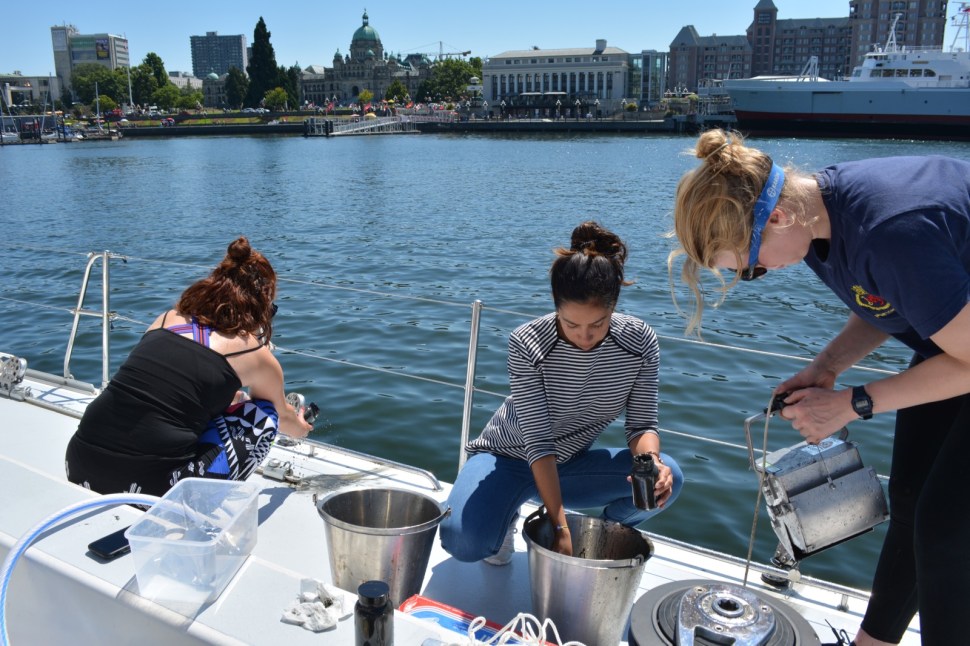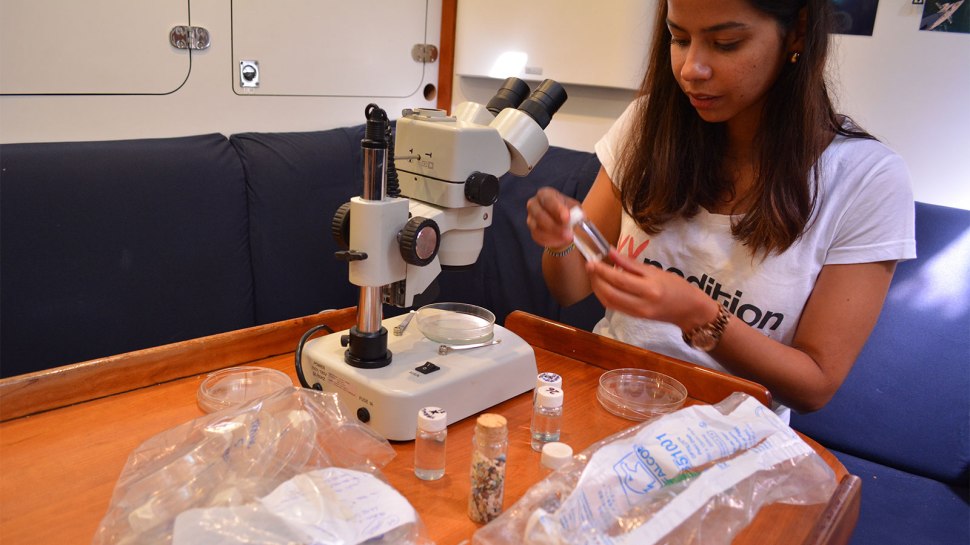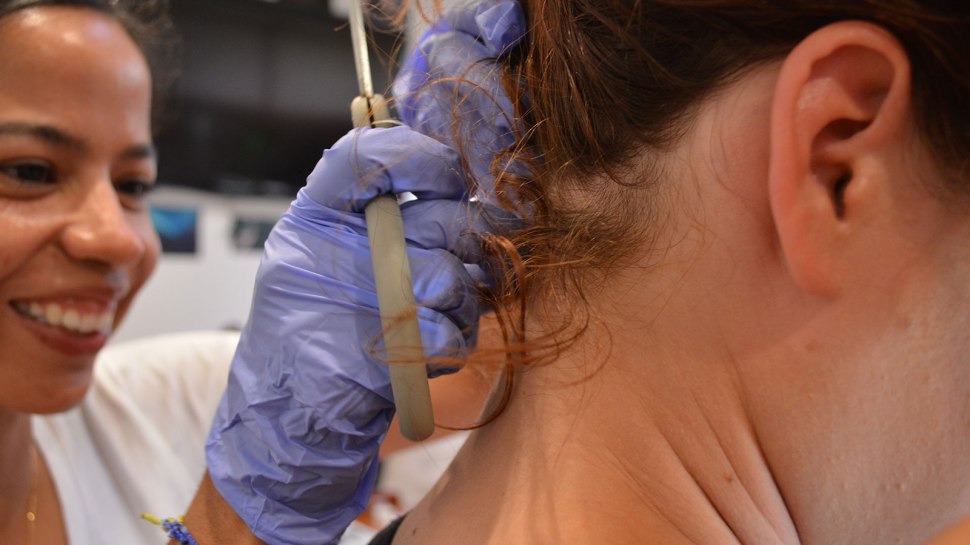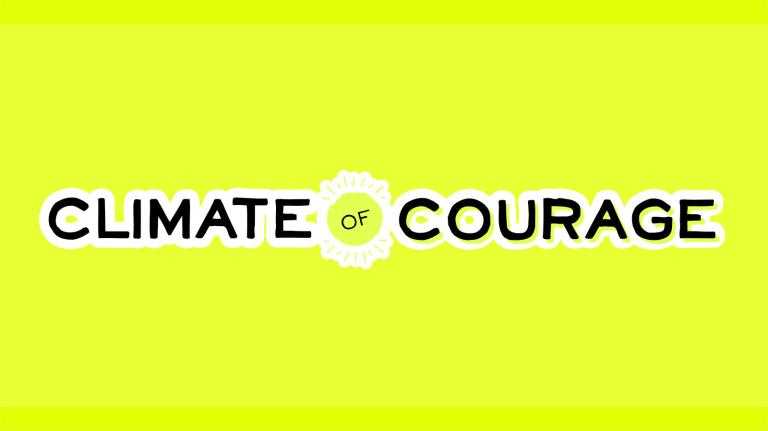When I arrive at the marina in Victoria on a late-July morning, the sky and water are complementary shades of azure, and there is not one cloud in the sky — a Pacific Northwestern idyll. On the deck of the 72-foot shiny-bright Sea Dragon, moored here in the island capital of British Columbia for just one day, are four young women, part of the crew of the research voyage “eXXpedition.” They’re hauling heavy buckets of black sludge up to the deck from the ocean floor, their labor set to a tinny radio serenade of Drake and Selena Gomez.
The team will meticulously pack the sludge — actually wet sand from the harbor floor — into little glass jars like you would some fresh vegetables you planned to pickle. These jars will be added to a library of sand, water, and air samples that they’ve collected over the past six weeks from across the North Pacific. They’ll ship some of those samples off to Plymouth, England, to be analyzed by eXXpedition’s marine scientist Imogen Napper. The idea is that by cataloging this library, she and the team will begin to get a better sense of what kind of plastic is out there in the ocean.
One thing they already know, because they’ve seen it every day for weeks: There is a whole lot of it. The Sea Dragon, with an all-woman crew of 14 aboard, launched from Hawaii in mid-June, traversing a part of the North Pacific Gyre known as the “Great Pacific Garbage Patch,” a swirling mass of trash the size of two Texases. The name conjures the image of great islands of refuse gently bumping up against each other, like a Waterworld made of old tires and sandwich bags. But, as eXXpedition founder Emily Penn tells me as we sway a bit on deck, it’s really more of a plastic soup, trillions of little bits and particles seasoning a million square miles of ocean.

Meg Tapp (left), Laura Leiva, and Imogen Napper collect samples from the floor of the marina in Victoria, B.C. Eve Andrews / Grist
“When we sailed into the southern edge of the Gyre, we started to see a piece of plastic over the side of the boat every 10 seconds — a cigarette lighter, a bottle, some sort of container,” she said. Her skin is tanned and her hair is bleached from weeks in Pacific sun, and as she describes the voyage, she’s dodging the spray of some deck-hosing that’s going on around us: “Then when you wake up the next morning, and it’s still going, and wake up seven days later, and it’s still going, and you’re 800 miles from the nearest human being — it’s that relentlessness that’s just so overwhelming.”
With this voyage, the eXXpedition is trying to make sense of that relentlessness. The women, a mix of scientists, sailors, writers, and activists, collected those samples of plastic from the air, water, and ocean floor to be analyzed not just in Napper’s lab but in others across the world. The point is that this problem is far larger than one very large patch in the North Pacific — plastic is found throughout all the oceans, in fish, in turtles, in shellfish, everywhere.
The samples that eXXpedition collected will help us understand how plastic might pick up other pollutants, like pesticides and industrial waste, and transfer them to humans through the food chain. In parallel with that work, the team also wrote about its experiences to raise awareness, and began developing ideas for both policy and technology to address this giant plastic dilemma.
One major mystery within that dilemma: what all these bits of plastic might be doing to us. For every tidbit of understanding we gain about the health consequences of chemicals released by plastics, there remains a Gyre-sized quantity of unknowns. But a growing body of evidence suggests some chemicals commonly found in many plastics are associated with everything from breast and prostate cancer, to underdeveloped genitalia and low sperm count in men, to obesity.
You’ve probably already heard about compounds like bisphenol A, which seeps into food and drinks from plastic bottles and canned-food liners — and has been tentatively linked to breast cancer and prostate cancer. That’s just one. There are many others. Some are merely suspected to be bad for human health; others are known to be dangerous.
They are scattered all around us — and even within us.
“So often when we talk about environmental problems we hear about things that are happening somewhere else, to somebody else, at some point in the future,” Penn wrote in the U.N. Chronicle magazine in 2014. “You and I already have a body burden, a chemical footprint that we will never get rid of.”
In particular, some of the substances that stick to plastics, seep out of them, or are released when they decay are endocrine-disrupting chemicals (EDCs), meaning that they interfere with the normal function of hormones in the human body. Some may contribute to cancer. They may also cross from a pregnant woman’s body into her fetus, potentially changing the way a baby develops.
It’s that last potential consequence of plastic junk that made Penn decide to found eXXpedition as an all-women’s endeavor. Men get these chemicals inside them as well, of course. “For women,” she said, “it felt like it was a greater significance because we’re passing them on to the next generation.”

Emily Penn, far left, talks with eXXpedition crew members Elise Chappell, Becca Finlayson, Meg Tapp, and Sarah Michler. Grist / Eve Andrews
All of us live with those compounds. You can’t live on this planet and not come into contact with the indelible dusting of plastic that covers it. We know it’s everywhere, but we don’t know nearly everything about what it does or how we’ve been changed by it. Penn and her team plan to help us find out.

The scientific exploration of the hormonal effects of compounds in plastics dates back to July 1991, when physician and biologist Ana Soto traveled to Wisconsin to attend a conference on the potential effects of chemical exposure on human sexual development. She had been invited because her lab had made an important, impromptu discovery two years earlier: The suppliers of a plastic tube that Soto and her colleague Carlos Sonnenschein used in their lab had changed the tube’s formula, in order to make it stronger. The researchers then noticed that the nutrient mixture they stored in these new tubes was causing cells in their test cultures to proliferate when they hadn’t before. Soto and Sonnenschein eventually figured out the cells were responding to a compound leaching from the new tubes, nonylphenol, as if it were the natural sex hormone estrogen.
This was the first compound in plastic ever identified as an “endocrine disruptor,” a term Soto and 20 other researchers introduced at the conference to refer to synthetic chemicals that interfere with hormone signals.
Your endocrine system includes glands like your thyroid, pancreas, and sex organs which release hormones that attach to receptors on the cells of your brain and organs, instructing your body how to behave or how to turn food into energy. In particular, these hormones coordinate growth and development. If you interfere with the activity of a hormone just a little bit, you can make big changes in how the body develops.
Exposure to sex hormones in the wrong quantity and at the wrong time may increase the likelihood that a person could one day develop cancer. Once Soto and her colleagues discovered what nonylphenol was doing, they suspected that it and other compounds that acted like sex hormones could also increase a person’s risk of cancer.
The best evidence to support that suspicion was a large, unintended human experiment involving diethylstilbestrol (DES), a synthetic estrogen prescribed to women from the 1940s through the 1960s to prevent miscarriages. It was eventually proven to be ineffective at preventing miscarriages, but tragically effective in producing babies who would grow up to develop vaginal cancer as adults. The incidence of vaginal cancer in women exposed to DES before birth was as much as 40 times higher than that of the rest of the population. (That said, it was still just a small risk: Only about 0.1 percent of DES-exposed babies went on to develop vaginal cancer.) Their rate of breast cancer was also about twice as high.
Soto’s laboratory experiments on endocrine disruptors, conducted at Tufts University in partnership with Sonnenschein, started in the mid-1990s and continues today. Her research has shown that rats exposed to endocrine-disrupting chemicals like BPA while still in the womb are more likely to develop tumors in their mammary glands, as well as fertility problems, obesity, and behavioral issues as adults.
But there are two major obstacles to answering the question of whether being exposed to compounds from plastic while still in the womb eventually causes cancer or other health problems later on in humans. For starters: We’re all exposed! How could you possibly find a control group — that is to say, people who don’t touch plastic all the time?
Secondly, even if you were able to find the very isolated person who had never been exposed to plastics, the timelines make it really challenging to identify the cause of a disease. Cancer can take decades to develop after an exposure — even a lifetime. On top of that, there’s reason to believe that EDCs have an outsized impact on fetuses, which are still developing and therefore are especially susceptible to the shifts in hormones caused by endocrine disruption. Exposure can cause subtle changes to the structure of an organ in development — a small abnormality in the breast ducts, a slightly atypical uterus shape — that grow into bigger problems like cancer or infertility as the organ matures. That’s why the results of endocrine disruption may not be seen until much later in life.
Nearly 30 years of research have transpired between that Wisconsin conference and today, Soto explained. And that work has produced a body of evidence that prenatal exposure to EDCs is tied to a higher incidence of various disorders. Animal experiments link prenatal EDC exposure to a higher incidence of altered behavior and cancer. These results, Soto said, “provide strong support to the idea that environmental chemicals that have hormone-like properties are at least one of the causes of the increase in breast and prostate cancer and reproductive problems throughout the population.”
Rolf Halden, director of the Center for Environmental Health Engineering at Arizona State University’s Biodesign Institute, agrees that scientists studying plastic pollution are generally confident of the mechanisms by which EDCs are toxic to the human body: They imitate hormones and mess up the signals in our bodies. Halden’s own 2010 review of studies concerning the impact of plastic exposure on human health collected evidence that there’s reason to be concerned.

Left: A sample of the plastic pieces collected throughout the eXXpedition voyage. Right: Mud from the Victoria marina floor, which will be shipped to the U.K. for analysis to determine what plastic materials and pollutants are in it. Grist / Eve Andrews
For example, in epidemiological studies, there’s a correlation between exposure to EDCs and endometriosis and polycystic ovarian syndrome in women, and reduced sperm count and genital abnormalities in men. Similarly, the incidence of neurodevelopmental disorders such as attention deficit hyperactivity disorder in children is correlated with their mothers’ exposure to EDCs — mothers with higher exposures to the compounds have children who are affected by these conditions at a higher rate. Other studies find a similar relationship between breast cancer in the children of mothers exposed to the endocrine-disrupting pesticide DDT.
In terms of everyday exposures to EDCs from plastics, however, the evidence isn’t always as clear. I asked Ruthann Rudel, a toxicologist with the Silent Spring Institute who researches the impact of environmental chemicals on breast cancer, exactly what that impact is. Rudel recently oversaw a review of studies of environmental factors that cause breast cancer, including endocrine disruptors in plastics. None of the studies were able to overcome those two major obstacles — the lack of the control group and the long delay.
“There wasn’t a human study that we thought was informative about plastics-related chemicals and breast cancer, although evidence from laboratory studies continues to raise concerns,” she said.
The official position of the Endocrine Society, the largest international medical organization devoted to endocrinology, is that there is a “possibility that low-level environmental exposure may still have significant and/or long-term biological impact.”
Just that possibility is concerning considering that the list of endocrine-disrupting chemicals now includes some phthalates — a component in many plastics, like Saran wrap, that makes them soft and pliable — which have been banned from products for small children in the European Union and are now starting to be phased out of products there and in the U.S. An estimated 1,000 others, many derived from plastics, are suspected to also interfere with normal hormonal function.
The problem is that our ingenuity in developing plastics has led to a bewildering variety of possible culprits to test — more than any scientist can ever hope to explore. “If we have to do all the research that we have done to determine endocrine-disrupting characteristics of BPA and nonylphenol and some phthalates, we will exterminate the rats and mice produced for research,” Soto said.
It’s a bigger job than researchers, studying one compound at a time, can hope to finish. That’s why Emily Penn believes that her work — sailing the world to build knowledge about plastics in the ocean, and get people to care about the problem — can make a difference. They cannot answer all those questions, but she and her crew can at least begin to raise the alarm about how much of this stuff is out there, what’s in and on it, and what impact it might have.

In the cramped common room below deck on the Sea Dragon, a table is scattered with Petri dishes containing pebbles of plastic in cobalt, lime, cream, and rose. They range somewhere between ice cream-sprinkle-sized and pea-sized. These have all come out of samples of water or sludge. Laura Leiva, a Honduran doctoral student at the Alfred Wegener Institute in Germany, shows me how they look under the microscope, with many, many little fibers sprinkled throughout each piece.

Laura Leiva prepares a sample from the Pacific Ocean for examination under her microscope. Grist / Eve Andrews
The sailboat’s seemingly endless nooks and crannies are packed with hundreds of these samples. There are little tubes of plastics that were pulled out of the water with a trawl. There are larger jars of ocean air samples — yes, there’s plastic in the air, too — which are going to be analyzed by Stephanie Wright, a researcher at King’s College London. She’ll examine whether fibers like the ones I saw under the microscope, when airborne, pose a risk for human lungs and airways.
She’ll also begin to theorize how airborne plastic fibers in marine environments end up there. A hypothesis with some traction is those fibers come off our clothes when we wash them, entering the ocean through sewage systems. That’s what Sarah Dudas, a British Columbia-based biologist with the government agency Fisheries and Oceans Canada and adjunct assistant professor at the University of Victoria, tells me their team has gleaned from its research. “Out of all the plastic particles we found,” she said, “most of them are textile-based” — tiny filaments from fabrics such as nylon and polyester.
Dudas began studying plastic in seafood in 2015. When shellfish farmers expressed concern that their aquaculture equipment might be shedding microplastics and contaminating their oysters and clams, she worked with the University of Victoria, Fisheries and Oceans Canada, and the British Columbia Shellfish Growers Association to find out. What would that do to the shellfish? they wondered. You and I might wonder: What would it do to the people who ate the shellfish?
Firm answers on that are yet to come. But what Dudas’ graduate researcher, Garth Covernton, did find was that all shellfish they sampled, whether they grew near a wild or farmed beach, had similar amounts of microplastics in them. The explanation for that, Dudas says, is likely just that microplastics are ubiquitous.
In one sample from the eXXpedition trip, the team counted more than 500 pieces of microplastic, which extrapolates to half a million pieces of plastic in a square kilometer of open sea. That’s not including all the far tinier nanoplastic shards that they know will show up on further inspection under a microscope.
This was not how it was supposed to be; plastics were developed to be indestructible. But it turns out they gradually disintegrate over time.
In 2009, Katsuhiko Saido, then a researcher at Nihon University in Japan, found that plastics are actually far less stable than believed; they decompose into pieces and particles. Saido’s research showed that as they break down into tinier and tinier pieces, plastics release endocrine-disrupting compounds such as BPA. Due to this process, he says, plastic debris in the ocean will give rise to new sources of global contamination that will persist long into the future.
The tininess of plastic pollution also can make it more dangerous to living things. These minute particles may persist for millennia, and they can also cross human tissue and embed themselves into organs, theoretically delivering a toxic payload at close range.
If you slurped down an oyster that had caught a plastic microbead, it would probably pass through your system and continue on its merry way. But a five-micrometer fiber in that oyster — perhaps shed from a jacket — is small enough to slip through the throat tissue, for example, and lodge in your body.
And now, you may have acquired a very, very, very tiny pollutant-soaked sponge. In addition to potentially releasing endocrine-disrupting chemicals itself, plastic is lipophilic — meaning it attracts other oil-based chemicals and can act as a magnet for organic pollutants around it, like DDT, flame retardants, and waterproofing materials that have washed into the water.
According to Arizona State’s Halden, plastics can concentrate those contaminants up to 100,000-fold, and then, at least in theory, carry that super-concentrated contaminant into the next creature that consumes it — a bit of plankton, a shrimp, a fish, and, continuing on down the food chain, maybe eventually to a human.
One test of that theory is being conducted by the crew of the Sea Dragon. During my visit, about half a dozen women of the eXXpedition crew gather around a bolted-down table below deck to snip clippings of each other’s hair and seal them away in little glassine envelopes. These samples will be analyzed for mercury, a persistent ocean pollutant that the team hypothesizes can be carried by plastic.

Laura Leiva cuts a piece of Meg Tapp’s hair, which she’ll analyze for mercury — a persistent ocean pollutant that the eXXpedition team hypothesizes can be carried by plastic. Grist / Eve Andrews
Because all of this is still mostly hypothetical, the eXXpedition team is sending the samples they’ve collected from the ocean water and air for the past six weeks to laboratories all around the world to test whether toxic compounds are in fact adhering to the plastic. Counting, identifying, and analyzing toxic substances in microscopic bits of plastic throughout nature is tedious and costly, to say the least. “But I do think that technology is developing so rapidly, that we’ll get there,” Dudas said. “It will just take some time.

Plastic is an element of our world now, and one that will probably be with us for a very long time. “The amount of plastic waste in our natural environment is reaching a tipping point where nature cannot digest it,” Katsuhiko Saido said.
So it’s not realistic to rid the entire ocean of plastics. We humans cannot clean up the mess we created. It’s just too big. And we will not stop producing these products altogether. “There is nothing that comes risk-free,” said Soto, the biologist who did early research on endocrine disruptors in plastic. “And I’m not saying we should be Luddites or return to the Paleolithic era.”
It is realistic and urgent, in the opinion of every scientist I spoke to for this article, to stop pursuing product innovation above all else, because new variations of synthetic materials are approved for market release every day without much analysis of their environmental or health impact. There are already ways to prevent the plastic problem from continuing to get worse, such as implementing stronger regulations to study a material’s impact before it’s sold, rather than after it’s ubiquitous. Shrinking the waste stream is also necessary.
After all, the problem will not just drift away. Before the eXXpedition reached Victoria, its last stop was at the Broken Group Islands, a smattering of remote, barely inhabited scraps of rock and greenery off the western coast of Canada’s Vancouver Island. This atoll is protected as part of the Pacific Rim National Park Reserve, and the only way to set foot on the islands is if you row, swim, or sail up to them yourself. In the mythology of the local Tseshaht tribe, part of the Nuu-chah-nulth First Nation, this is where the first man and woman were put on Earth.
Laura Leiva, the Honduran student studying in Germany, tells me that on the shores of these islands, the team found plastics in big, recognizable chunks. The bits that retained recognizable labels showed Japanese characters, indicating that they’d floated all the way across the Pacific.
Even in Eden, there is plastic.




